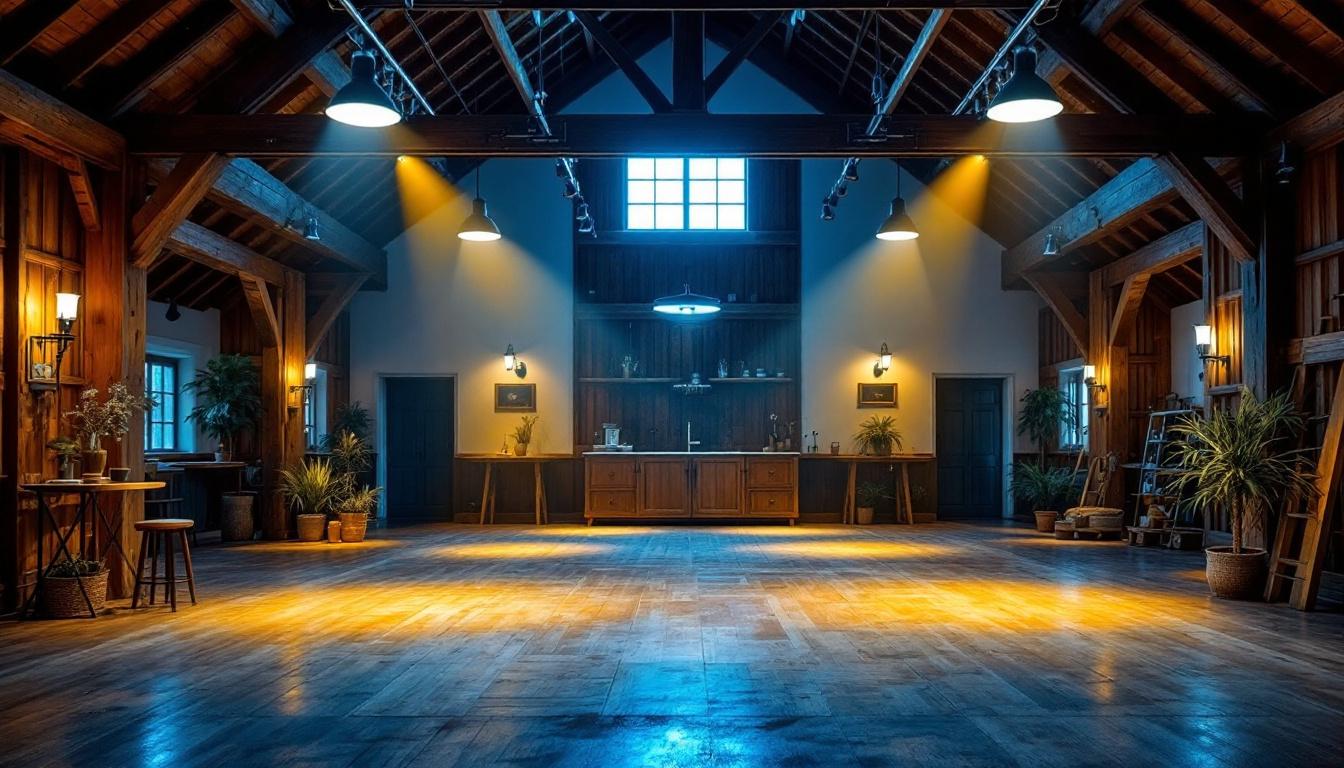
When it comes to illuminating barns, lighting contractors face unique challenges that require a blend of creativity, technical knowledge, and an understanding of the space’s purpose. Whether the barn is used for agricultural purposes, events, or storage, the right lighting can transform the environment, enhance functionality, and create an inviting atmosphere. However, many contractors make common mistakes that can compromise the effectiveness of their designs. This article explores these pitfalls and offers insights into effective barn lighting ideas.
Before diving into lighting solutions, it is crucial for contractors to fully comprehend the specific needs and characteristics of the barn. Each barn is distinct, and understanding its purpose will guide the selection of appropriate lighting fixtures. Factors such as the barn’s size, layout, and the activities that will take place within its walls can all impact the effectiveness of the lighting design. A thorough assessment will ensure that the chosen lighting not only meets functional requirements but also enhances the overall aesthetic of the space.
The first step in designing a lighting plan is to assess how the barn will be used. For instance, a barn designated for livestock will require different lighting than one used for hosting events. Livestock barns benefit from bright, even lighting to ensure the safety and well-being of the animals. In contrast, event spaces may require a combination of ambient and accent lighting to create a warm and inviting atmosphere. Additionally, barns used for storage or equipment may necessitate focused lighting to illuminate specific areas, allowing for easy access and organization of tools and supplies. Understanding these varied functionalities is essential for creating a tailored lighting solution that meets all needs effectively.
Another critical aspect to consider is the availability of natural light. Many barns feature large doors or windows that can significantly influence the lighting design. Contractors should evaluate how much natural light the space receives throughout the day and consider how artificial lighting can complement or enhance this natural illumination. For instance, strategically placed skylights can maximize daylight exposure, reducing the need for artificial lighting during daylight hours. Furthermore, the orientation of the barn can play a pivotal role in how natural light enters the space; south-facing openings often receive the most sunlight, making them ideal for brightening up interior areas. By taking advantage of these natural light sources, contractors can create a more energy-efficient lighting plan that not only saves on electricity costs but also promotes a healthier environment for both people and animals alike.
Even experienced lighting contractors can fall into traps that lead to ineffective lighting solutions. Identifying these common mistakes can help avoid costly revisions and ensure that the final design meets the client’s expectations.
One of the most significant mistakes contractors can make is neglecting energy efficiency. In an age where sustainability is paramount, selecting energy-efficient lighting options is not just beneficial for the environment but also for the client’s bottom line. LED lights, for example, consume less energy and have a longer lifespan compared to traditional incandescent bulbs. By prioritizing energy efficiency, contractors can provide clients with cost-effective solutions that reduce long-term operational expenses. Furthermore, energy-efficient lighting can significantly lower the barn’s carbon footprint, aligning with modern agricultural practices that emphasize environmental stewardship. This consideration not only appeals to eco-conscious clients but also enhances the overall marketability of the property.
Lighting zoning is another often-overlooked aspect of barn lighting design. Different areas of the barn may require varying levels of illumination based on their function. For instance, storage areas may need less light than workspaces. Implementing zoned lighting with control options allows for flexibility and customization, enabling users to adjust the lighting according to their needs. Failing to incorporate these features can lead to an inefficient lighting setup that does not cater to the barn’s diverse functions. Additionally, integrating smart lighting controls can further enhance the user experience, allowing for automated schedules and remote adjustments via smartphone applications. This modern approach not only improves convenience but can also lead to significant energy savings by ensuring lights are only on when necessary.
Safety should always be a top priority in any lighting design. Barns often house equipment, livestock, and people, making it essential to adhere to safety regulations and standards. Contractors must ensure that all lighting fixtures are properly installed and meet local codes. Additionally, using fixtures that are rated for wet or damp locations is crucial, especially in barns where moisture may be present. Neglecting these considerations can lead to hazardous situations and potential liability issues. Moreover, incorporating features such as emergency lighting and adequate exit signage can further enhance safety protocols, ensuring that the barn remains a secure environment even in unforeseen circumstances. Regular maintenance checks on the lighting system can also help identify potential hazards before they escalate, fostering a culture of safety that benefits everyone involved.
While avoiding common mistakes is vital, it is equally important to explore creative lighting solutions that enhance the barn’s functionality and aesthetic appeal. Innovative lighting designs can transform a mundane barn into a stunning space that meets the needs of its users. The right lighting can evoke a sense of warmth and welcome, making the barn not just a functional space but also a gathering place for friends and family. Whether it’s for hosting events, showcasing livestock, or simply enjoying a cozy evening, the right lighting can set the mood and elevate the overall experience.
Layered lighting involves combining different types of lighting—ambient, task, and accent—to create a well-balanced and versatile environment. Ambient lighting provides overall illumination, while task lighting focuses on specific areas, such as workstations or reading nooks. Accent lighting can highlight architectural features or decorative elements. By employing layered lighting techniques, contractors can create a dynamic atmosphere that is both functional and visually appealing. For example, strategically placed wall sconces can complement overhead fixtures, creating a warm glow that enhances the barn’s rustic charm. Additionally, dimmable options allow users to adjust the lighting according to the time of day or the type of activity, further enhancing the space’s adaptability.
Pendant and track lighting are excellent choices for barns, especially in areas with high ceilings. Pendant lights can add a touch of style while providing focused illumination over work areas or dining spaces. Track lighting offers flexibility, allowing contractors to direct light where it is needed most. This adaptability is particularly beneficial in multi-functional barns, where the layout may change depending on the event or activity. Furthermore, selecting fixtures that reflect the barn’s character—such as industrial-style pendants or rustic track lights—can create a cohesive design that resonates with the surrounding environment. The interplay of light and shadow created by these fixtures can also enhance the barn’s architectural features, drawing attention to beams, trusses, or other unique elements.
Smart lighting technology is revolutionizing how spaces are illuminated, and barns are no exception. By integrating smart lighting systems, contractors can provide clients with the ability to control their lighting remotely, set schedules, and adjust brightness levels. This technology not only enhances convenience but also promotes energy savings. For instance, lights can be programmed to turn off automatically when the barn is not in use, reducing energy waste. Additionally, smart lighting can be integrated with motion sensors, ensuring that areas are only illuminated when occupied. This feature is particularly useful in barns that may not be used daily, as it allows for efficient energy management without sacrificing accessibility. The ability to customize lighting scenes for different occasions—such as a festive gathering or a quiet evening—can further enhance the barn’s functionality, making it a truly versatile space for all types of activities.
After the installation of a lighting system, maintenance becomes a crucial aspect of ensuring its longevity and effectiveness. Contractors should educate clients about proper maintenance practices and the importance of regular inspections.
Given the unique environment of a barn, selecting durable and weather-resistant fixtures is essential. Fixtures that can withstand the elements will require less frequent replacement and maintenance. Contractors should consider materials such as stainless steel or high-quality plastics that can endure moisture, dust, and temperature fluctuations.
Creating a maintenance schedule is vital for keeping the lighting system in optimal condition. Regularly checking for burnt-out bulbs, cleaning fixtures, and inspecting wiring can prevent larger issues down the line. By establishing a routine maintenance plan, clients can ensure their barn remains well-lit and functional for years to come.
Designing an effective lighting plan for barns involves a careful balance of creativity, functionality, and safety. By understanding the unique characteristics of the space and avoiding common mistakes, lighting contractors can create solutions that enhance the barn’s usability and aesthetic appeal. From energy-efficient fixtures to smart lighting technology, there are numerous opportunities to innovate and elevate barn lighting design. Ultimately, a well-executed lighting plan not only improves the barn’s functionality but also contributes to a more enjoyable environment for all who use it.
Ready to avoid common lighting mistakes and elevate your barn projects with the right fixtures? At LumenWholesale, we provide lighting contractors with spec-grade lighting products that combine quality, affordability, and convenience. Our extensive selection is designed to meet the highest industry standards, ensuring your barn lighting is both functional and stunning. With unbeatable wholesale prices, free shipping, and no middleman, you can trust us to light up your barn spaces efficiently. Take the first step towards superior barn lighting solutions and discover wholesale lighting at the best value today.

Discover how front door lights with sensors can revolutionize your lighting installation projects.

Discover why purchasing Bluetooth control systems in bulk from local distributors might not be your best bet.

Discover the comprehensive guide to mastering RGB lighting with “RGB Light 15: The Ultimate Handbook for Lighting Contractors.” Uncover expert tips, innovative techniques, and essential tools to elevate your lighting projects and stay ahead in the industry.

Discover the essential insights from Jacques Risler’s expertise in lighting contracting.